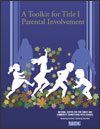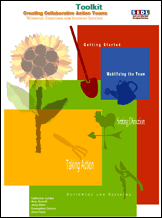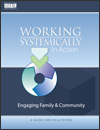Toolkits
The Center has developed several toolkits for family and community engagement with schools shown below.
A Toolkit for Title I Parental Involvement

A Toolkit for Title I Parental Involvement is designed to provide information to those who are implementing Title I Part A parental involvement provisions. The toolkit provides two types of information:
- Explanations for Title I, Part A notification and involvement provisions—This text describes the actions and processes that State Education Agencies (SEAs), Local Education Agencies (LEAs), and schools must take to meet the provisions of Title I, Part A.
- Possible tools—These tools provide examples of information sheets, checklists, letters, surveys, and other resources SEAs, LEAs, and schools use to assist them in implementing Title I, Part A notification and involvement provisions
Beyond the Building: A Facilitation Guide for School, Family, and Community Connections

Beyond the Building is a multimedia toolkit designed to help educators and community organizers understand and learn how to facilitate family and community involvement through four key sections.
- Introduction Family and Community Connections with Schools–understand the central themes found in current research.
- Exploring the Syntheses–build an understanding of current research findings.
- Investigating the Research–learn how to make quality decisions aligned to research on effective programs.
- Moving to Practical Applications–apply your new knowledge.
Materials include:
- activities with facilitator’s instructions.
- four of SEDL’s best-selling research syntheses on Family and Community Connections with Schools each on a different topic.
- seven strategy briefs each focusing on a different aspects of family and community connections with schools.
- three interactive learning modules in flash format.
- referenced handouts.
Creating Collaborative Action Teams (CATs) Toolkit

The Collaborative Action Team process is a set of concepts, activities, and resources that individuals, school districts and other organizations can use to develop a partnership between home, school, community, and students at the local level. These teams identify pressing issues in the school community and take action to address those issues with the purpose of promoting student success.
Stages and Steps in the Process- Stage 1: Getting Started
- Stage 2: Mobilizing the Team
- Stage 3: Setting Direction
- Stage 4: Taking Action
- Stage 5: Reviewing and Refining
Working Systemically in Action: Engaging Family & Community

Many educators recognize the importance of family and community involvement in school improvement efforts and are seeking to reframe the way they engage these groups. Working Systemically in Action: Engaging Family & Community, which supplements Working Systemically in Action: A Facilitator’s Guide, provides practical guidance for educators who are seeking to engage family and community members in systemic school improvement efforts.
SEDL’s Working Systemically approach is a process for school improvement—and, ultimately, increased student achievement—that focuses on key components and competencies at all levels of the local educational system. Working Systemically in Action: Engaging Family & Community provides
- best practices,
- an overview of the Working Systemically approach to school improvement,
- actions and tools for involving families and community in all phases of the Working Systemically process,
- examples of how to incorporate family and community engagement into a systemic approach, and
- research on family and community engagement.
This guide is written for educators, but anyone who supports effective family and community engagement will find it useful.
